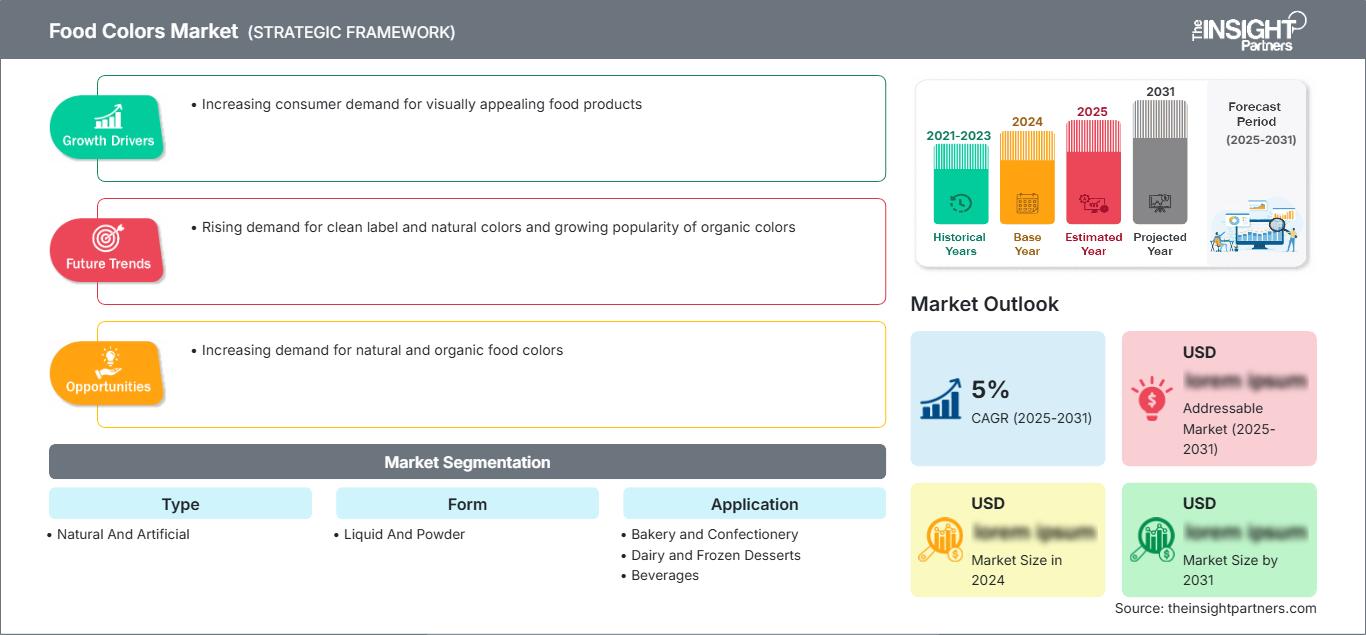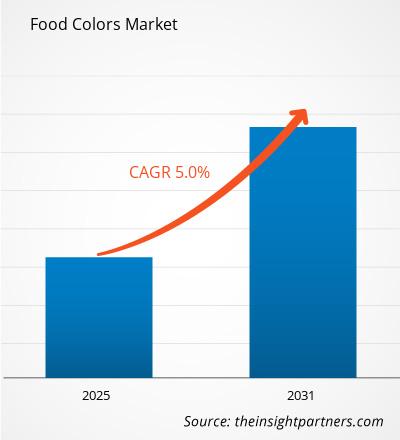Se espera que el mercado de colorantes alimentarios alcance los 6.550 millones de dólares estadounidenses para 2031. Se prevé que registre una tasa de crecimiento anual compuesta (TCAC) del 6,7 % entre 2025 y 2031. La creciente demanda de colorantes naturales y de etiqueta limpia, así como la creciente popularidad de los colorantes orgánicos, probablemente seguirán siendo una tendencia clave en el mercado.
Análisis del mercado de colorantes alimentarios
- El mercado mundial de colorantes alimentarios está creciendo a un ritmo significativo; los factores responsables de ello son la mayor demanda de alimentos procesados y de conveniencia, la inclinación del consumidor por un mejor sabor, textura y apariencia; los principales factores impulsores de esto incluyen la rápida urbanización, los cambios en la dieta y el aumento del ingreso disponible.
- El mercado está segmentado por tipo, forma y aplicación.
- Las áreas de aplicación de los colorantes alimentarios abarcan una amplia gama de productos alimenticios que abarcan panadería, confitería, snacks, productos cárnicos entre otros.
- Los principales actores de este sector se están centrando en el desarrollo de productos innovadores, específicamente colores orgánicos y de etiquetas limpias, manteniendo el aumento constante en las demandas de los consumidores de alimentos de larga duración ganando terreno indirectamente para el mercado de colorantes alimentarios.
Descripción general del mercado de colorantes alimentarios
- Los colorantes alimentarios son aditivos que se utilizan para mejorar o modificar la apariencia de los alimentos y bebidas.
- Se pueden clasificar en colorantes naturales y sintéticos. Los colorantes alimentarios naturales provienen de fuentes vegetales, animales o minerales, como la remolacha, la cúrcuma, el carmín y la espirulina.
- Estos son cada vez más populares debido a la demanda de los consumidores de productos de etiqueta limpia.
- Los colorantes alimentarios sintéticos, también conocidos como colorantes artificiales, se producen químicamente e incluyen compuestos como Rojo 40, Amarillo 5 y Azul 1. Estos suelen proporcionar una coloración más vibrante y estable, pero enfrentan escrutinio debido a preocupaciones de salud.
- Los colorantes alimentarios vienen en varias formas, incluidos líquidos, polvos, geles y pastas.
Personalice este informe según sus necesidades
Obtendrá personalización en cualquier informe, sin cargo, incluidas partes de este informe o análisis a nivel de país, paquete de datos de Excel, así como también grandes ofertas y descuentos para empresas emergentes y universidades.
Mercado de colorantes alimentarios: perspectivas estratégicas

- Obtenga las principales tendencias clave del mercado de este informe.Esta muestra GRATUITA incluirá análisis de datos, desde tendencias del mercado hasta estimaciones y pronósticos.
Impulsores y oportunidades del mercado de colorantes alimentarios Se espera que la creciente demanda de los consumidores de productos alimenticios visualmente atractivos impulse el crecimiento del mercado de colorantes alimentarios.
- La creciente preferencia de los consumidores por productos alimenticios visualmente atractivos ha surgido como una fuerza fundamental que impulsa la expansión del mercado de colorantes alimentarios.
- Esta tendencia es multifacética y está influenciada por diversos factores sociales y tecnológicos.
- La ubicuidad de las plataformas de redes sociales, particularmente Instagram y Pinterest, ha elevado la estética de la comida a niveles sin precedentes, transformando las comidas en experiencias visuales que se comparten globalmente.
- Esta vitrina digital de alimentos ha aumentado las expectativas de los consumidores, obligando a los fabricantes de alimentos a priorizar el atractivo visual de sus productos.
Creciente demanda de colorantes alimentarios naturales y orgánicos
- La creciente demanda de colorantes alimentarios naturales y orgánicos representa una oportunidad fundamental en el mercado de colorantes alimentarios, impulsada por una confluencia de preferencias de los consumidores, presiones regulatorias y tendencias de la industria.
- Este cambio tiene su origen en una creciente conciencia de la salud entre los consumidores, que cada vez son más cautelosos con los aditivos sintéticos y buscan productos con ingredientes limpios y reconocibles.
- El movimiento de etiqueta limpia ha ganado un impulso sustancial, obligando a los fabricantes de alimentos a reformular sus productos utilizando colorantes naturales derivados de frutas, verduras y otras fuentes vegetales.
- Los organismos reguladores de todo el mundo están endureciendo las restricciones sobre los aditivos alimentarios artificiales, catalizando aún más la transición hacia alternativas naturales.
Análisis de segmentación del informe de mercado de colorantes alimentarios
Los segmentos clave que contribuyeron a la derivación del análisis del mercado de colorantes alimentarios son el tipo, la forma y la aplicación.
- Según el tipo, el mercado de colorantes alimentarios se divide en naturales y artificiales.
- Según la forma, el mercado de colorantes alimentarios se divide en líquido y en polvo.
- Según la aplicación, el mercado de colorantes alimentarios se segmenta en panadería y confitería, productos lácteos y postres congelados, bebidas, productos RTC y RTE, salsas, aderezos y condimentos, carnes, aves y mariscos, y otros.
Análisis de la cuota de mercado de colorantes alimentarios por geografía
- El informe de mercado de colorantes alimentarios comprende un análisis detallado de cinco regiones geográficas principales, que incluye el tamaño actual e histórico del mercado y pronósticos para 2021 a 2031, cubriendo América del Norte, Europa, Asia-Pacífico (APAC), Medio Oriente y África (MEA) y América del Sur y Central.
- Cada región se subdivide en sus respectivos países. Este informe proporciona análisis y pronósticos de más de 18 países, abarcando la dinámica del mercado de colorantes alimentarios, como los factores impulsores, las tendencias y las oportunidades que impactan los mercados a nivel regional.
- Además, el informe cubre el análisis de las Cinco Fuerzas de Porter, que implica el estudio de los principales factores que influyen en el mercado de colorantes alimentarios en estas regiones.
Perspectivas regionales del mercado de colorantes alimentarios
Los analistas de The Insight Partners han explicado detalladamente las tendencias regionales y los factores que influyen en el mercado de colorantes alimentarios durante el período de pronóstico. Esta sección también analiza los segmentos y la geografía del mercado de colorantes alimentarios en Norteamérica, Europa, Asia Pacífico, Oriente Medio y África, y Sudamérica y Centroamérica.
Alcance del informe de mercado de colorantes alimentarios
| Atributo del informe | Detalles |
|---|---|
| Tamaño del mercado en 2024 | XX mil millones de dólares estadounidenses |
| Tamaño del mercado en 2031 | 6.550 millones de dólares estadounidenses |
| CAGR global (2025-2031) | 6,7% |
| Datos históricos | 2021-2023 |
| Período de pronóstico | 2025-2031 |
| Segmentos cubiertos | Por tipo
|
| Regiones y países cubiertos | América del norte
|
| Líderes del mercado y perfiles de empresas clave |
|
Densidad de actores del mercado de colorantes alimentarios: comprensión de su impacto en la dinámica empresarial
El mercado de colorantes alimentarios está creciendo rápidamente, impulsado por la creciente demanda del consumidor final debido a factores como la evolución de las preferencias del consumidor, los avances tecnológicos y un mayor conocimiento de los beneficios del producto. A medida que aumenta la demanda, las empresas amplían su oferta, innovan para satisfacer las necesidades del consumidor y aprovechan las tendencias emergentes, lo que impulsa aún más el crecimiento del mercado.

- Obtenga una descripción general de los principales actores clave del mercado de colorantes alimentarios
Noticias y desarrollos recientes del mercado de colorantes alimentarios
El mercado de colorantes alimentarios se evalúa mediante la recopilación de datos cualitativos y cuantitativos tras la investigación primaria y secundaria, que incluye importantes publicaciones corporativas, datos de asociaciones y bases de datos. A continuación, se enumeran algunos de los avances en el mercado de colorantes alimentarios:
- Phytolon y Ginkgo Bioworks alcanzan con éxito el primer hito en la producción de vibrantes colorantes alimentarios naturales mediante dos cepas productoras. (Fuente: Boletín informativo de Ginkgo Bioworks, enero de 2024)
- La nueva combinación de colores naturales Rojo y Rosa de Oterra ofrece la opción inteligente de "planta por planta". (Fuente: Boletín informativo de Oterra, junio de 2023)
Cobertura y resultados del informe de mercado de colorantes alimentarios
El informe "Tamaño y pronóstico del mercado de colorantes alimentarios (2021-2031)" proporciona un análisis detallado del mercado que abarca las siguientes áreas:
- Tamaño del mercado de colorantes alimentarios y pronóstico a nivel global, regional y nacional para todos los segmentos clave del mercado cubiertos bajo el alcance
- Tendencias del mercado de colorantes alimentarios, así como dinámicas del mercado, como impulsores, restricciones y oportunidades clave.
- Análisis detallado PEST/de las cinco fuerzas de Porter y FODA
- Análisis del mercado de colorantes alimentarios que abarca las tendencias clave del mercado, el marco global y regional, los principales actores, las regulaciones y los desarrollos recientes del mercado.
- Análisis del panorama industrial y de la competencia que abarca la concentración del mercado, el análisis de mapas de calor, los actores destacados y los desarrollos recientes del mercado de colorantes alimentarios.
- Perfiles detallados de empresas
- Análisis histórico (2 años), año base, pronóstico (7 años) con CAGR
- Análisis PEST y FODA
- Tamaño del mercado, valor/volumen: global, regional y nacional
- Industria y panorama competitivo
- Conjunto de datos de Excel
Informes recientes
Informes relacionados
Testimonios
Razón para comprar
- Toma de decisiones informada
- Comprensión de la dinámica del mercado
- Análisis competitivo
- Información sobre clientes
- Pronósticos del mercado
- Mitigación de riesgos
- Planificación estratégica
- Justificación de la inversión
- Identificación de mercados emergentes
- Mejora de las estrategias de marketing
- Impulso de la eficiencia operativa
- Alineación con las tendencias regulatorias




















 Obtenga una muestra gratuita para - Mercado de colorantes alimentarios
Obtenga una muestra gratuita para - Mercado de colorantes alimentarios